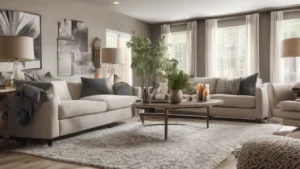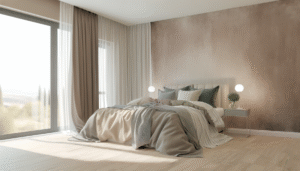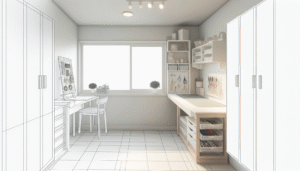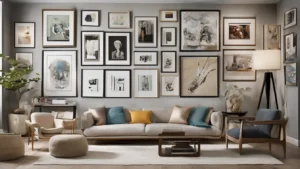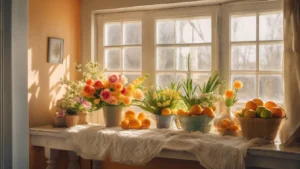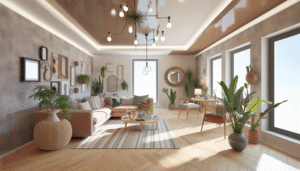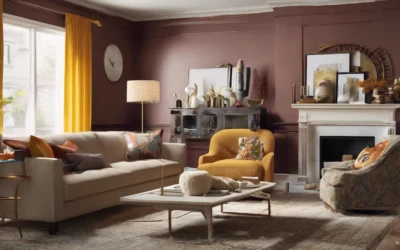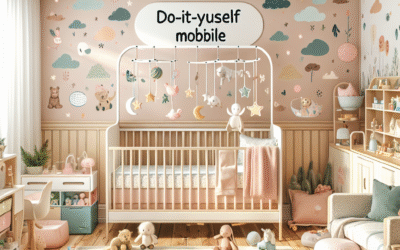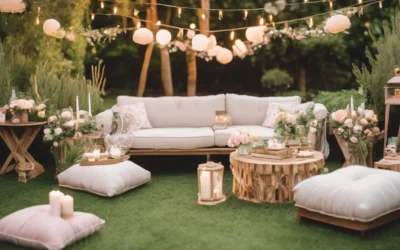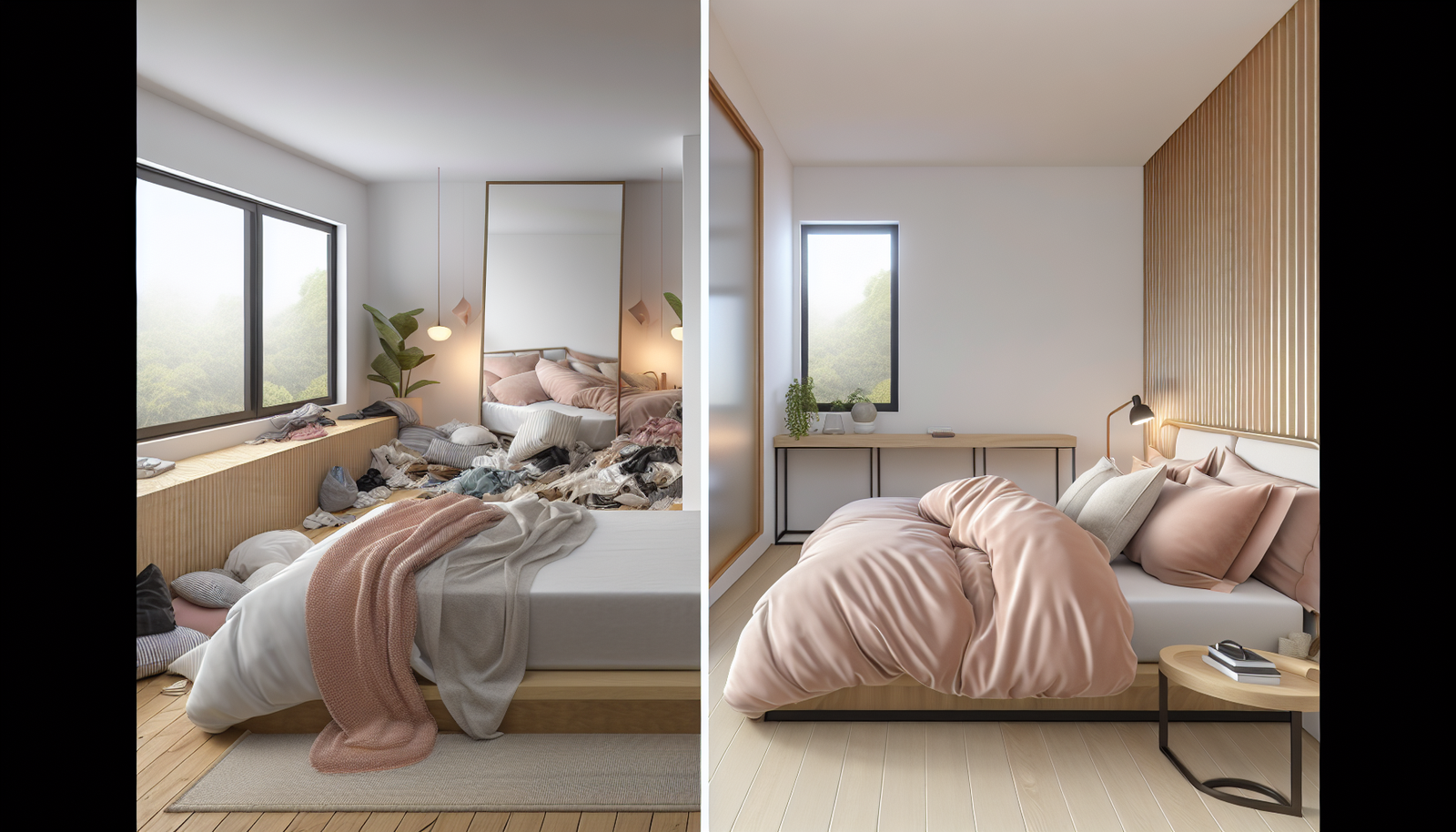
The Comfort Confession: How Soft Blush Transformed Our Bedroom into a Sanctuary
Ever walked into a room and instantly felt a calming embrace, a gentle sigh of relief? For years, our bedroom felt more like a functional space than a refuge. It served its purpose – a place to sleep – but it lacked soul, that intangible element that turns a house into a home. We yearned for a genuine retreat, a sanctuary where the day’s stresses dissolved the moment we stepped inside. And then, we discovered soft blush. This wasn’t merely a color choice; it was a revelation, a transformation that reshaped not just the aesthetic of our room, but our entire relationship with rest, comfort, and personal well-being. The impact of soft blush on our bedroom was profound, turning a mundane space into a blissful haven we never want to leave.
This article isn’t just about paint swatches and fabric choices. It’s a deep dive into the psychology of color, the often-overlooked power of subtle design, and the tangible benefits of crafting a personal sanctuary. We’ll explore why soft blush works its magic, how to practically integrate it into your space, and what surprising ripple effects you can expect. From optimizing your sleep environment to fostering a deeper sense of tranquility, you’ll uncover the secrets to creating your own dream retreat. Get ready to embark on a journey that will not only redefine your bedroom but elevate your daily life.
The Psychology of Soft Blush: More Than Just a Pretty Color
Soft blush, often perceived as a muted pink, holds a unique position in the color spectrum. It’s not the vibrant, energetic pink of childhood, nor the bold, assertive fuchsia of a statement piece. Instead, it’s a whisper, a gentle sigh. But its understated elegance belies a profound psychological impact. Understanding why soft blush is so effective for creating a sanctuary begins with delving into its inherent qualities and associations.
The Calming Effect: A Visual Lullaby for the Senses
Imagine the soft glow of a sunset, the delicate petals of a blossoming rose, or the warmth of human skin. Soft blush evokes these natural, comforting images. Scientifically, colors with lower saturation and brightness, like soft blush, tend to have a calming effect on the human nervous system. They lower heart rate, reduce muscle tension, and promote a sense of security and safety. In a world saturated with digital screens and constant stimuli, a color that actively encourages relaxation is an invaluable asset, especially in a bedroom where rest is paramount.
Many color therapists and interior designers champion soft blush for its ability to induce tranquility. It acts as a visual lullaby, gently coaxing your mind and body into a state of repose. Unlike stark whites or vibrant blues that can feel cold or stimulating, soft blush feels embracing, almost like a warm hug. This inviting quality is crucial for a space meant for unwinding.
Versatility and Sophistication: Beyond the Stereotypes
For a long time, pinks, including blush, were pigeonholed as overtly feminine or childish. This perception is rapidly changing. Modern design embraces soft blush as a sophisticated, gender-neutral shade that exudes warmth and understated luxury. Its versatility is truly remarkable; it pairs beautifully with an array of other colors and textures, making it a flexible foundation for various design styles, from minimalist to bohemian, classic to contemporary.
- Minimalist: Soft blush walls paired with concrete floors and simple white linens create a serene, uncluttered aesthetic.
- Bohemian: Combine blush with woven textiles, natural wood, and rich greens for an earthy, eclectic vibe.
- Classic: Blend it with antique furniture, brass accents, and deep blues or greens for a timeless, elegant look.
The key to its sophistication lies in its subdued nature. It doesn’t demand attention; rather, it complements and softens, allowing other elements in the room to shine while providing a harmonious backdrop. This makes soft blush an excellent choice for a bedroom because it supports a sense of balance and calm, rather than overwhelming the senses.
A Touch of Warmth: Combating Clinical Coldness
Often, attempts to create a serene bedroom can lead to clinical, sterile environments. White walls and stark furniture, while bright, can sometimes feel uninviting or cold, especially in low light. Soft blush introduces a much-needed touch of warmth without sacrificing lightness or airiness. Its subtle red undertones provide a gentle glow that makes a room feel cozier and more welcoming. This warmth is vital for a space designed for intimacy and relaxation. It bridges the gap between stark modernity and overwhelming traditionalism, finding a perfect middle ground that appeals to a broad range of tastes.
In essence, soft blush isn’t just a trend; it’s a timeless color that speaks to our innate human need for comfort, calm, and connection. Its psychological benefits, combined with its aesthetic versatility, make it an unparalleled choice for transforming a bedroom into a true sanctuary.
From Barren to Blissful: Our Soft Blush Bedroom Makeover Journey
Our bedroom transformation wasn’t an overnight revelation. It was a gradual evolution, driven by a desire for genuine change. Before soft blush entered the picture, the room was a purgatory of indecision and half-hearted attempts at coziness. Picture this:
- The Walls: A tired, off-white that had long lost its vibrancy, showing scuffs and ghosts of old art.
- The Furniture: Mismatched dark wood pieces, inherited or purchased out of necessity, contributing to a heavy, uninspired feel.
- The Lighting: A single, harsh overhead light that cast unflattering shadows, making the room feel like a waiting area rather than a personal retreat.
- The Textiles: Functional but unexciting bedding in various shades of beige and gray, offering no sensory delight.
It was tidy, yes, but utterly devoid of personality and, more importantly, peace. We knew we needed a change, but the sheer number of options felt paralyzing.
The “Aha!” Moment: Discovering Soft Blush
Our breakthrough came during a brainstorming session, scrolling through countless interior design blogs and Pinterest boards. We kept gravitating towards images of serene bedrooms that shared a common thread: a subtle, almost ethereal pink hue on the walls or in key decor elements. It wasn’t ‘pink’ as we knew it, but something softer, more refined. We finally identified it as ‘soft blush.’
Initially, there was hesitation. “Isn’t that too feminine?” “Will it feel childish?” These were valid concerns, but the consistent warmth and tranquility radiating from the images convinced us to take the leap. We purchased a few samples, painted swatches on the wall, and observed them throughout the day. The way the light played off the delicate shade, shifting from a warm ivory in the morning to a muted rose at sunset, was captivating. It felt right.
Strategic Implementation: Layering in the Blush
Our transformation wasn’t about splashing blush everywhere. It was a strategic, layered approach to create depth and cohesion. Here’s how we integrated soft blush to achieve maximum sanctuary effect:
1. The Wall Color: Setting the Tone
We started with the largest canvas: the walls. After extensive sampling, we settled on a specific soft blush shade that had just enough warmth to feel inviting without being overwhelming. The immediate effect was astonishing. The room instantly felt brighter, yet remarkably softer. The previous starkness vanished, replaced by an inviting glow that seemed to absorb and diffuse light beautifully. This was the foundational step, setting the entire mood for the sanctuary.
2. Textiles: Softness and Texture
Next, we focused on textiles, which are crucial for enhancing comfort and layering color. We swapped out our old bedding for luxurious linen sheets in a complementary muted white, adding a plush duvet cover in a slightly deeper, dustier rose blush. Throw pillows in varying textures – a velvet deep blush, a knitted cream, and a subtle patterned blush – added visual interest and an irresistible invitation to sink in. We also added thick, blackout curtains in a similar soft blush hue, which not only completed the color scheme but also significantly improved sleep quality by blocking out external light.
3. Accent Pieces: Subtle Echoes
To tie everything together without overdoing it, we carefully selected a few accent pieces. A large, abstract art print featuring soft blush tones, grays, and creams became the focal point above the bed. A ceramic vase on the nightstand holding dried floral arrangements with hints of blush and beige provided a delicate touch. Even the choice of bedside lamps with natural wood bases and linen shades contributed to the overall soft, warm aesthetic.
Complementary Colors: The Supporting Cast
Soft blush truly shines when paired with the right complementary colors. We found success with:
- Warm Whites and Creams: For trim, ceilings, and primary bedding, providing a crisp but not harsh contrast.
- Natural Woods: Light oak or birch for furniture, adding warmth and grounding the space.
- Grays (Cool & Warm): Used in rugs, throws, and subtle patterns to add sophistication and depth without competing with the blush.
- Metallic Accents (Brass or Matte Gold): For hardware, lamps, or decorative objects, adding a touch of understated elegance.
- Muted Greens: Through plants or small accent pieces, providing a natural, soothing contrast.
The transformation was dramatic. What was once a functional, forgettable room became a haven, a soft blush sanctuary. The air felt lighter, the space more expansive yet cocooning. This wasn’t just a decor change; it was a shift in energy, a daily invitation to unwind, recharge, and truly relax.
Beyond Aesthetics: The Tangible Benefits of a Sanctuary Bedroom
While the visual appeal of our soft blush bedroom was undeniable, what truly surprised us were the profound, tangible benefits that extended far beyond aesthetics. A bedroom designed as a sanctuary fundamentally changes your relationship with sleep, stress, and self-care. It’s an investment in your well-being, yielding dividends in unexpected ways.
1. Enhanced Sleep Quality: A Gateway to Deep Rest
The most immediate and impactful benefit we experienced was a dramatic improvement in sleep quality. Before the soft blush transformation, sleep felt like a nightly chore. Now, entering the bedroom feels like stepping into a peaceful cocoon. The serene environment, aided by the calming presence of soft blush and the thoughtful integration of other elements, signals to the brain that it’s time to unwind. Here’s how it helps:
- Calming Visuals: Soft blush reduces visual overstimulation, helping your mind quiet down. Unlike bright, bold colors that can keep you alert, this gentle hue acts as a visual sedative.
- Improved Ambiance: The warm, diffused light from strategically placed lamps, complemented by the blush walls, creates a nurturing glow. This low, comforting light cues your body for melatonin production, aiding in natural sleep cycles.
- Reduced Stress Before Bed: The sensation of stepping into a sanctuary melts away the day’s anxieties. This pre-sleep relaxation is critical for falling asleep faster and achieving deeper, more restorative sleep stages. When your environment feels truly inviting, your body is more receptive to rest.
We found ourselves falling asleep more quickly, experiencing fewer disturbances throughout the night, and waking up feeling more refreshed and energized. This renewed sense of vitality carries through the entire day.
2. Stress Reduction and Mental Clarity: A Daily Reset Button
Our bedroom became our daily reset button. The world outside the bedroom door can be chaotic, but within our soft blush haven, harmony reigns. This shift significantly impacts stress management and mental clarity:
- Mindful Unwinding: The environment encourages intentional relaxation. Instead of mindlessly scrolling, we find ourselves reading, meditating, or simply sitting in quiet contemplation.
- Emotional Regulation: A calm room fosters a calm mind. In times of stress or emotional intensity, retreating to the sanctuary allowed us to process thoughts and feelings in a peaceful space, preventing escalation.
- Enhanced Focus: Paradoxically, by promoting relaxation, the sanctuary also improved our ability to focus when needed. Without the constant hum of underlying stress, our minds were clearer for creative thinking, problem-solving, or simply planning the next day.
It’s not just about what you do in the room, but how the room makes you feel. The sense of peace spills over into other aspects of life, making daily challenges feel more manageable.
3. Elevated Mood and Well-being: Nurturing Your Inner Self
Perhaps the most subtle, yet profound, benefit has been the consistent elevation of our mood and overall sense of well-being. A sanctuary bedroom isn’t just a place to sleep; it’s a space where you feel nurtured, valued, and at peace. This nurtures your inner self in various ways:
- Self-Care Encouragement: The inviting atmosphere encourages regular self-care rituals, whether it’s a luxurious bath before bed, a quiet moment of journaling, or simply enjoying a cup of herbal tea.
- Positive Associations: The room becomes associated with comfort, safety, and happiness. This positive conditioning reinforces feelings of well-being every time you enter.
- Inspiration and Creativity: For some, the enhanced tranquility can even spark creativity. A mind at ease is more open to new ideas and perspectives.
This isn’t about escaping reality, but about creating pockets of profound peace that equip you to better engage with life. Our soft blush bedroom has truly become a testament to the idea that our physical environment profoundly shapes our inner world and daily experience.
Crafting Your Own Soft Blush Sanctuary: Practical Steps & Expert Tips
Inspired to create your own soft blush sanctuary? Excellent! This section provides practical, actionable steps and expert tips to guide you through the process, ensuring your bedroom becomes the tranquil retreat you envision. Remember, it’s not just about slapping on some pink paint; it’s about thoughtful layering, intelligent pairing, and an understanding of how elements interact to create a cohesive, calming atmosphere.
Step 1: Choosing Your Perfect Soft Blush Shade
This is arguably the most crucial step. “Soft blush” isn’t a single color; it’s a spectrum. Factors like undertones, light reflection, and saturation will drastically change how the color appears in your space.
- Warm vs. Cool Undertones: Some soft blushes lean more towards peach (warm), others towards lavender or gray (cool). Consider your existing furniture and natural light. Northern facing rooms benefit from warmer blushes, while southern facing rooms can handle cooler tones.
- Intensity: Do you want a whisper-soft hue that’s barely there, or a slightly deeper, dustier rose? The lighter the shade, the more expansive the room will feel. Deeper shades create a cozier, more enveloping feel.
- Sample, Sample, Sample: This cannot be stressed enough. Buy sample pots and paint large swatches on at least two walls in your bedroom. Observe them at different times of day (morning, afternoon, evening, with lights on and off). The color will change dramatically with light. Live with the swatches for a few days before deciding.
- Explore Brands: Paint brands have unique takes on soft blush. Check out popular shades like “Setting Plaster” by Farrow & Ball, “Shell Pink” by Benjamin Moore, or “Pink Ground” also by Farrow & Ball for inspiration. Paint stores can also custom mix, but start with existing popular shades first.
Step 2: Layering with Complementary Colors & Textures
Once your blush base is established (whether on walls or a key piece of furniture), it’s time to layer in supporting elements. This is where the magic happens, creating depth and preventing the room from feeling one-dimensional or overwhelming.
| Element | Soft Blush Integration | Complementary Colors/Textures | Impact |
|---|---|---|---|
| Walls | Full wall paint or accent wall | Warm whites, creams (trim/ceiling), light grays | Foundation of serenity, soft glow |
| Bedding | Duvet cover, throw, accent pillows | Crisp white, linen, muted grays, natural creams, deep greens | Luxurious comfort, inviting softness |
| Curtains | Blackout or sheer panels | Matching blush, warm white, light gray, soft gold | Light control, privacy, cohesive aesthetic |
| Rugs | Area rug under bed | Cream, warm gray, muted natural fiber (jute, wool) | Adds warmth, defines space, acoustic dampening |
| Furniture | Upholstered headboard, accent chair | Natural wood (light oak, birch), white lacquer, brass/gold metals | Grounds the space, adds structure |
| Decor Accents | Vases, candles, art, books | Metallics (brass, copper), ceramics, natural elements (wood, stone), muted greens | Personalizes, adds visual interest, subtle echoes of color |
Expert Tip: Focus on varying textures – smooth silks, nubby linens, cozy knits, plush velvets. This adds tactile richness and visual interest, making the room feel more luxurious and inviting.
Step 3: Lighting for Ambiance, Not Just Illumination
Lighting is paramount in a sanctuary space. It should contribute to the mood, not just brightness.
- Layered Lighting: Avoid single overhead lights. Incorporate bedside lamps for reading, a floor lamp for ambient light, and perhaps string lights or candles for a soft glow.
- Warm White Bulbs: Opt for LED bulbs with a color temperature between 2200K and 3000K (warm white) for a cozy, inviting light. Avoid anything above 4000K (cool white), which can feel harsh and clinical.
- Dimmer Switches: Install dimmer switches on all light sources. This allows you to control the intensity of light, transitioning from brighter functional light to soft atmospheric glow.
- Natural Light Control: Pair your soft blush curtains with blinds or shades for maximum light control. Blackout options are excellent for improving sleep.
Step 4: Incorporating Natural Elements and Personal Touches
To truly feel like a sanctuary, the room should connect you with nature and reflect your personality.
- Live Plants: Even a small plant can purify the air and add a touch of life and vibrant green, which beautifully contrasts with soft blush. Opt for low-maintenance options like snake plants, ZZ plants, or peace lilies.
- Natural Materials: Introduce wood, stone, rattan, and linen. These elements add an organic feel and groundedness.
- Personal Meaning: Display meaningful artwork, cherished photographs (in simple frames), or souvenirs that evoke positive memories. Avoid clutter; select a few precious items that bring you joy and a sense of calm.
- Aromatherapy: Consider an essential oil diffuser with calming scents like lavender, chamomile, or frankincense to engage another sense in your sanctuary experience.
Creating your soft blush sanctuary is a journey of intentional design. Each element should contribute to the overall feeling of peace, comfort, and well-being. Take your time, experiment, and most importantly, enjoy the process of transforming your bedroom into your ultimate personal refuge.
The Soft Blush Palate: Exploring Compatible Hues for Harmony
While soft blush is undoubtedly the star of our sanctuary-themed bedroom, its true power often comes from its ability to harmonize with a diverse range of other colors. The right pairings can elevate the space, adding depth, sophistication, and a sense of completeness. Understanding the soft blush palate means knowing which hues act as supporting characters, allowing blush to truly sing.
1. Whites and Creams: The Pure Foundation
This is a quintessential pairing. Warm whites and creamy off-whites are the natural companions to soft blush. They provide a crisp, clean contrast without being stark or cold. Used for ceilings, trim, or primary bedding, they allow the blush to pop subtly while maintaining an airy, expansive feel. Think of a luxurious hotel suite where crisp white linens meet soft, inviting wall tones.
- Usage: Ceilings, baseboards, door frames, window treatments, primary duvet, pillowcases.
- Effect: Brightens, creates a sense of freshness, enhances airiness.
2. Grays: From Understated to Sophisticated
Grays, especially those with green or blue undertones (cooler grays) or slightly warmer, greige tones, offer a sophisticated contrast to soft blush. They ground the ethereal quality of blush, adding a contemporary edge.
- Cool Grays: Create a modern, calming atmosphere. Think charcoal for an accent wall or lighter dove gray for a rug.
- Warm Grays/Greiges: Provide a softer, more inviting contrast that blends seamlessly, creating a cozy yet refined feel. Excellent for upholstered furniture or throws.
- Usage: Area rugs, accent chairs, accent walls, throw pillows, decorative objects.
- Effect: Adds depth, modernity, and a sense of groundedness.
3. Natural Wood Tones: Earthy Warmth
The organic warmth of natural wood is an essential element in any sanctuary space, and it beautifully complements soft blush. Light woods like white oak, birch, or maple add an earthy, Scandinavian-inspired touch, enhancing the feeling of tranquility and connection to nature. Darker woods, used sparingly, can provide a striking contrast and a touch of traditional elegance.
- Usage: Bed frames, nightstands, dressers, flooring, decorative bowls.
- Effect: Introduces organic warmth, texture, and a grounded, natural feel.
4. Metallic Accents (Brass & Matte Gold): A Touch of Elegance
For a subtle touch of glamour and warmth, brass or matte gold metallic accents are perfect. Their golden hues resonate with the warmth in soft blush, creating a sophisticated and inviting glow without being overly opulent. Avoid highly polished chrome or silver, which can feel too cool.
- Usage: Lamp bases, picture frames, drawer pulls, decorative trays, small sculptures.
- Effect: Adds a hint of luxury, reflects light, and enhances warmth.
5. Muted Greens: Nature’s Soothing Touch
Inspired by foliage and natural landscapes, muted greens (think sage, dusty olive, or eucalyptus green) introduce a refreshing and calming contrast to soft blush. This pairing is often found in nature and creates a balanced, harmonious, and truly peaceful environment.
- Usage: Live plants are ideal, but also consider throw pillows, small decorative objects, or a subtle pattern in artwork.
- Effect: Connects the space to nature, provides a soothing complementary contrast, and adds a breath of fresh air.
6. Deep Blues (Used Sparingly): Dramatic Sophistication
While less common, a very deep, muted navy or dusty blue can act as a sophisticated accent against soft blush, particularly if you’re aiming for a slightly more dramatic or elevated feel. Use these sparingly, perhaps as a focal art piece or a statement armchair, to provide a rich anchor without overwhelming the serene qualities of the blush.
- Usage: Accent chair, large artwork, a single throw pillow (very sparingly).
- Effect: Adds depth, sophistication, and a contrasting anchor point.
The magic of the soft blush palate lies in its ability to adapt. By carefully curating these supporting colors and textures, you can create a bedroom that is not only visually stunning but also deeply comforting and conducive to profound rest and relaxation. Each hue plays its part in building a harmonious, welcoming sanctuary that truly reflects your desire for peace.
Future-Proofing Your Sanctuary: Longevity and Adaptability
One of the beauties of choosing soft blush as a foundational color for your bedroom sanctuary is its inherent timelessness and adaptability. Trends come and go, but the calming, versatile nature of blush ensures your sanctuary remains relevant, serene, and easily refreshed without necessitating a complete overhaul every few years. This section explores how to “future-proof” your soft blush bedroom for lasting appeal and evolving tastes.
The Enduring Appeal of Soft Blush
Unlike bold, trendy colors that can quickly feel dated, soft blush, particularly in its muted, sophisticated iterations, has an enduring quality. It’s subtle enough to blend into various design aesthetics and warm enough to feel inviting year-round. It’s essentially a neutral with a hint of personality, making it a safe choice for longevity. This makes soft blush a truly valuable investment in your living space.
- Timelessness: Soft blush evokes natural elements like skin tones, sunsets, and delicate flowers, which are inherently timeless.
- Versatility: It performs beautifully across seasons, looking fresh in spring, warm in autumn, and comforting in winter.
- Broad Appeal: Its muted nature allows it to be appreciated by a wide range of tastes, avoiding the polarizing effect of more saturated colors.
Seasonal Adaptations: Refreshing Your Sanctuary with Ease
One of the most effective ways to keep your sanctuary feeling fresh is through subtle seasonal adaptations. Because soft blush is so adaptable, you can easily shift the mood of the room without repainting or buying new furniture.
- Spring/Summer: Introduce lighter, airier textiles. Think crisp white linen bedding, sheer white curtains, and vibrant green plants. Add small accents of brighter pastels like mint green or sky blue in throw pillows or decorative objects.
- Autumn/Winter: Layer in cozy textures. Swap out lightweight duvets for chunky knit throws in warm grays or deep creams. Introduce velvet pillows in a muted moss green or charcoal. Add warm-toned lighting, perhaps through amber-colored bulbs or more candles, enhancing the inherent warmth of soft blush.
These small changes can dramatically alter the feel of the room, keeping it dynamic and aligned with the seasons of your life.
Evolving with Your Style: Small Tweaks, Big Impact
Your personal style will naturally evolve over time. The groundwork laid by soft blush allows for easy shifts in aesthetic without requiring a major renovation. This is fundamentally about understanding the concept of a focal point and accentuating elements.
- Accessory Swap: This is the simplest and most cost-effective way to update. Change out throw pillows, artwork, vases, and decorative objects.
- Example: If you move from a bohemian phase to a more modern minimalist look, swap out woven wall hangings for sleek framed prints, and replace macrame plant hangers with concrete planters.
- Textile Update: Bedding, curtains, and rugs can significantly alter a room’s vibe.
- Example: Transition from a rustic linen duvet to a luxurious sateen, or swap a shag rug for a flat-weave geometric pattern.
- Furniture Accent: A single piece of accent furniture can redefine the space. A new armchair, nightstand, or ottoman can set a different tone.
- Example: Replacing a dark wood nightstand with a white mirrored one immediately lightens and modernizes the feel.
Investment Pieces vs. Trendy Accents
To truly future-proof, adopt a smart purchasing strategy:
- Invest in Core Pieces: Spend more on major furniture items like your bed frame, dresser, and even high-quality rugs in neutral or enduring finishes (natural wood, white, gray). These will last and serve as a stable foundation.
- Budget on Trendy Accents: Save money on smaller, easily replaceable items like throw pillows, decorative objects, and even certain light fixtures. These are your opportunities to experiment with current trends without breaking the bank.
By making conscious choices about color, layering, and investment, your soft blush sanctuary won’t just be beautiful today; it will remain a cherished, adaptable haven for years to come, consistently providing comfort and well-being as your life and style evolve.
Advanced Sanctuary Elements: Beyond the Basics for Ultimate Comfort
While the soft blush palette forms the beautiful foundation of a bedroom sanctuary, true transcendence comes from integrating advanced elements that engage all the senses and cater to deeper levels of comfort and well-being. Moving beyond paint and textiles, these considerations elevate a pleasant room to an immersive, restorative experience.
1. Acoustic Comfort: Silence and Soundscape
Noise pollution is a significant disruptor of sleep and peace. A true sanctuary considers how sound is managed within the space.
- Soundproofing/Dampening:
- Heavy Curtains: Thick, lined curtains (especially blackout ones) do more than block light; they absorb sound, reducing external noise.
- Rugs & Carpets: A substantial area rug or wall-to-wall carpet can significantly muffle footsteps and internal echoes.
- Wall Hangings: Tapestries, large framed artwork, or acoustic panels (disguised as art) can absorb sound waves, creating a quieter environment.
- White Noise/Nature Sounds: For those who benefit from auditory masking, a high-quality white noise machine or a sound machine playing gentle nature sounds (rain, ocean waves) can provide a consistent, calming backdrop that drowns out jarring noises.
Case Study Integration: A user on a sleep forum, Sarah M., struggled with city noise. After installing thick velvet curtains and placing a large wool rug, she reported, “The room suddenly felt hushed, like stepping into a private bubble. My sleep improved dramatically because the constant hum of traffic was finally gone.”
2. Air Quality and Aromatherapy: Breathing Easy for Deeper Rest
The air you breathe impacts your sleep and overall well-being. A sanctuary optimizes air quality and introduces calming scents.
- Air Purifiers: A good quality air purifier can remove allergens, dust, and pollutants, which is especially beneficial for those with allergies or respiratory sensitivities. Choose models that operate quietly.
- Indoor Plants: Beyond their aesthetic appeal, certain plants are excellent air purifiers (e.g., Snake Plant, Peace Lily, Spider Plant). They also add natural beauty and a calming visual.
- Aromatherapy:
- Essential Oil Diffusers: Use calming essential oils like lavender, chamomile, frankincense, or cedarwood before bedtime. Start with a few drops and find your preferred intensity.
- Natural Scents: Linen sprays, sachets of dried lavender, or natural beeswax candles can also subtly scent the air without artificial fragrances.
3. Temperature Regulation: The Perfect Climate for Sleep
An optimal sleep environment is consistently cool.
- Thermostat Control: Aim for a bedroom temperature between 60-67°F (15-19°C) for ideal sleep.
- Breathable Bedding: Invest in natural fiber bedding like linen, cotton, or bamboo, which are excellent for wicking away moisture and regulating temperature throughout the night.
- Ventilation: Ensure good airflow. Open windows for a short period daily (weather permitting) or use a quiet fan to circulate air.
4. Digital Detox and Blue Light Management: Disconnecting to Reconnect
Our addiction to screens is a major sleep disruptor. A true sanctuary encourages a digital detox.
- Charging Station Outside the Bedroom: Implement a strict “no phones in bed” policy. Charge devices in a common area.
- Blue Light Blocking Glasses: If screen use is unavoidable (e.g., reading on an e-reader), use blue light-blocking glasses an hour or two before bed.
- “Analog” Alternatives: Encourage reading physical books, journaling, or quiet conversation instead of screen time.
Comparison Element: Screen Use vs. Sanctuary Principles
| Feature | High Screen Use | Sanctuary Principle |
|---|---|---|
| Blue Light Exposure | Inhibits melatonin, suppresses sleepiness. | Eliminated 1-2 hours before bed. |
| Mental Stimulation | Keeps mind active, promotes anxiety. | Calm, quiet reflection, mindfulness. |
| Sleep Quality Impact | Fragmented, less restorative sleep. | Deep, uninterrupted, refreshing sleep. |
Tool Recommendations:
- Hatch Restore: A sound machine, smart light, and alarm clock that combines sounds, light, and meditations for winding down and waking up.
- Phone Lock Boxes: Simple, physical boxes to lock phones away for a set period.
By thoughtfully integrating these advanced elements, your soft blush bedroom sanctuary transcends mere decoration. It becomes a holistic environment designed to nurture your body, calm your mind, and provide the deepest possible rest, truly transforming your well-being.
FAQ: Your Soft Blush Sanctuary Questions Answered
Curious about creating your own tranquil retreat? Here are some frequently asked questions about designing a soft blush bedroom sanctuary, optimized for clarity and search visibility.
What makes soft blush a good color for a bedroom sanctuary?
Soft blush is ideal for a bedroom sanctuary due to its inherent calming and soothing psychological effects. Its muted tone promotes relaxation, reduces visual overstimulation, and creates a warm, inviting atmosphere that helps the mind and body unwind, fostering better sleep and a sense of peace.
How do I choose the right shade of soft blush for my bedroom?
Choosing the right shade of soft blush involves considering your room’s natural light and preferred undertones. Sample several shades by painting large swatches on different walls and observing them throughout the day. Look for blushes with warm (peachy) or cool (gray/lavender) undertones that complement your existing furniture and overall home aesthetic.
What colors pair well with soft blush in a bedroom?
Soft blush pairs beautifully with warm whites, creamy off-whites, and various shades of gray for a sophisticated look. Natural wood tones (light oaks, birch), metallic accents (brass, matte gold), and muted greens (sage, eucalyptus) also create a harmonious, balanced, and calming environment that enhances the sanctuary feel.
Can a soft blush bedroom feel masculine or gender-neutral?
Absolutely! Modern soft blush shades are far from overtly feminine. By pairing blush with grounding elements such as dark woods, charcoal grays, natural textures like linen and concrete, and clean-lined furniture, a soft blush bedroom can feel sophisticated, warm, and entirely gender-neutral, appealing to a broad range of tastes.
What are some key elements beyond color for a truly serene bedroom?
Beyond color, a truly serene bedroom incorporates elements like layered, warm lighting with dimmers, natural fiber textiles (linen, cotton), acoustic dampening (rugs, heavy curtains), excellent air quality (purifiers, plants), and a commitment to digital detox. These elements work together to create an environment that encourages deep rest and rejuvenation.
How can I incorporate soft blush without painting the walls?
You can easily integrate soft blush without painting the walls. Consider a soft blush upholstered headboard, blush-toned bedding (duvet covers, throws, pillows), or curtains. Large area rugs with blush accents, abstract artwork featuring the color, or decorative elements like ceramic vases and candles can also introduce the calming hue effectively.
What kind of lighting works best in a soft blush sanctuary?
Layered lighting with warm white bulbs (2200K-3000K) and dimmer switches is ideal. Incorporate bedside lamps for reading, a floor lamp for ambient light, and overhead lighting (if necessary) that can be dimmed. This allows for adaptable illumination, from brighter functional light to a soft, intimate glow conducive to relaxation and sleep.
Conclusion: Embrace the Soft Blush Sanctuary for a Life Transformed
Our journey from a functional, uninspired bedroom to a deeply comforting soft blush sanctuary has been nothing short of transformative. It wasn’t just a decor update; it was a conscious decision to invest in our well-being, to create a dedicated space where the stresses of daily life could genuinely melt away. The subtle power of soft blush, combined with thoughtful design and attention to detail, has gifted us not only with a beautiful room but with tangible improvements in our sleep, mental clarity, and overall sense of peace. This comfort confession is a testament to the profound impact our immediate environment has on our inner world.
This article has explored the psychology behind soft blush’s calming effect, walked through the practical steps of creating such a space, and highlighted the tangible benefits that extend far beyond mere aesthetics. We’ve delved into how to choose the perfect shade, harmoniously pair it with complementary hues, and integrate advanced elements like acoustic comfort and digital detox, truly future-proofing your sanctuary for lasting appeal. The soft blush bedroom has become our haven, a daily invitation to unwind, recharge, and reconnect with ourselves.
We encourage you not to view this as just another design trend, but as an opportunity to cultivate a space that truly nurtures your soul. Whether you embrace a full soft blush immersion or start with subtle accents, taking steps to create your personal sanctuary is a powerful act of self-care. It’s about crafting an environment that supports your deepest need for rest, reflection, and rejuvenation. Start small, experiment, and allow the gentle embrace of soft blush to guide you towards a more peaceful, centered life. Your own comfort confession awaits.
Ready to Create Your Sanctuary?
- Discover essential sleep hygiene tips to complement your new bedroom design.
- Explore minimalist bedroom ideas for a clean, uncluttered space.
- Learn about the psychology of color in interior design for deeper insights into home aesthetics.
Content Disclaimer
The information provided in this article is for general informational and educational purposes only, and is not a substitute for professional design advice or specific health recommendations. While we share our personal experiences and insights, individual results and preferences may vary. Always consult with qualified professionals for personalized guidance regarding interior design or health-related concerns. We do not provide financial, medical, or professional services advice. Product recommendations are based on our research and experience; however, we receive no compensation for these recommendations.
Categories
- Accent Walls & Ceilings (61)
- Art Curation & Gallery (62)
- Bedding Style Trends (68)
- Bedroom Makeover (81)
- Bohemian & Eclectic Styles (58)
- DIY & Budget-Friendly Decor (64)
- Eco-Friendly Design (62)
- Furniture Care (71)
- Home Decor & Design Ideas (162)
- Home Wellness Spaces (59)
- Integrated Outdoor Living (67)
- Japandi Style (61)
- Kids and Nursery Decor (59)
- Living Room Decor (79)
- Mix & Match Techniques (73)
- Modern & Contemporary Design (66)
- Rug Sizing & Placement (73)
- Scandinavian Design Inspiration (20)
- Seasonal Home Decor (79)
- Small Space Solutions (73)
- Wall Art & Painting Tips (77)
Recent Comments
Archives
Product Gallery
-
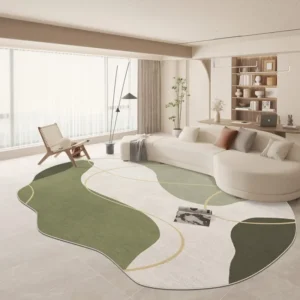 Large Area Green Rugs for Bedroom Nordic Living Room Decoration Shaped Carpet Irregular Plush Lounge Rug Home Thick Washable Mat
Rated 5.00 out of 5$54.94 – $346.41Price range: $54.94 through $346.41
Large Area Green Rugs for Bedroom Nordic Living Room Decoration Shaped Carpet Irregular Plush Lounge Rug Home Thick Washable Mat
Rated 5.00 out of 5$54.94 – $346.41Price range: $54.94 through $346.41 -
 Nordic Style Rugs for Bedroom Morandi Living Room Decoration Carpet Large Area Geometry Lounge Rug Home Cloakroom Non-slip Mat
Rated 5.00 out of 5$39.46 – $597.66Price range: $39.46 through $597.66
Nordic Style Rugs for Bedroom Morandi Living Room Decoration Carpet Large Area Geometry Lounge Rug Home Cloakroom Non-slip Mat
Rated 5.00 out of 5$39.46 – $597.66Price range: $39.46 through $597.66 -
 Irregular Shapes Living Room Decoration Carpet Modern Style Rugs for Bedroom Home Thicken Plush Rug Fluffy Soft Lounge Floor Mat
Rated 4.83 out of 5$55.84 – $347.37Price range: $55.84 through $347.37
Irregular Shapes Living Room Decoration Carpet Modern Style Rugs for Bedroom Home Thicken Plush Rug Fluffy Soft Lounge Floor Mat
Rated 4.83 out of 5$55.84 – $347.37Price range: $55.84 through $347.37

